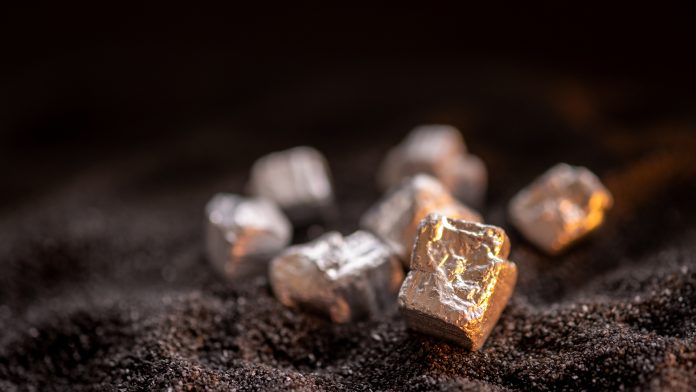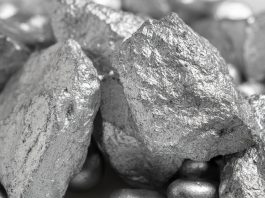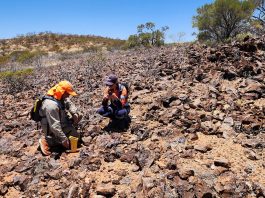ASX-listed Olympio Metals Limited is a diversified critical mineral explorer, with a strong focus on carbonatite-hosted REE mineralisation. Here, the company tells us more.
Olympio Metals Ltd (Olympio) has secured a significant proportion of the Walloway-Eurelia carbonatite-kimberlite field in South Australia, which is highly prospective for rare earth elements (REE) and niobium (Nb) (Fig. 1 and 2). Limited historical REE exploration has presented promising grades:
- Historical trench sampling returned results of up to 819ppm Nb and 1.02% Total Rare Earth Oxides (TREO) (separate samples, Fig. 2); and
- Historical drill hole recorded 9m at 1,647ppm TREO from 7m (ORR-K7-AC01), with the majority of historical drilling not assayed for REE mineralisation (Fig. 2)
The Eurelia project is a joint venture between Copper Claim and Olympio, covering mineral exploration licence EL6374. The entirely owned Walloway project is an exploration licence application (ELA), immediately south of Eurelia (Fig. 2), due to be granted in mid-2023.
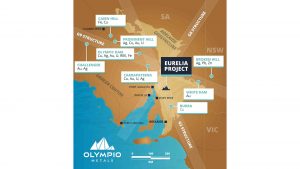
The Walloway project area covers a portion of a defined carbonatite – the Walloway carbonatite – which the company believes is highly prospective for niobium and/or REE mineralisation. The Walloway carbonatite occurs at the southern end of the extensive Eurelia kimberlite field (Fig. 2). Carbonatite and kimberlite fields are often coincident, as both rock types are emplaced from the mantle via deep crustal structures. The Mt Weld carbonatite (Western Australia) occurs within a kimberlite dyke field.
Olympio is the first explorer to recognise the potential for large-scale REE/Nb mineralisation within the Walloway carbonatite and surrounding carbonatite/kimberlite province. There has been very little REE exploration of the Walloway carbonatite, or the many high-priority magnetic carbonatite targets that Olympio has defined (see Fig. 2 and 3). Olympio has recently re-assayed historical trench/rock samples, confirming and exceeding historical REE assays (see Fig. 2).
Carbonatites are a type of intrusive igneous rock occurring typically as plugs, dykes, or sills. They are generally associated with major crustal-scale features (Fig. 1) and originate from the mantle. Carbonatite-hosted mineralisation is one of the main sources of economic REE and niobium ores globally, with Lynas Rare Earths’ (LYC: ASX) large Mt Weld mine in Western Australia and MP Minerals’ large Mountain Pass mine in California both hosted in carbonatites.
Technical discussion
Walloway carbonatite (Target W1)
The Walloway carbonatite is part of a suite of small dykes and plugs of carbonatite rock types, discovered in 1971. It occurs on the very eastern margin of the Walloway ELA (Fig. 2 and 3). Despite limited sampling, all mantle rock types within the Walloway-Eurelia carbonatite-kimberlite field show elevated REE and Nb (Fig. 2), indicative of regional-scale REE/incompatible element prospectivity. Further exploration is planned to establish the scale and characteristics of the enrichment.
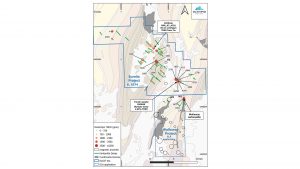
Historical REE sampling of the Walloway carbonatite is limited to a handful of rock chip samples. Three historical carbonatite dyke rock chip samples within the ELA recorded TREO values in the range 0.16-0.18% TREO and included grades of 518ppm Nb. The carbonatite is essentially unexplored for REE/Nb.
A highly detailed 2010 magnetic survey covers the Walloway carbonatite (Fig. 3). The survey indicates that the Walloway carbonatite is much larger than the currently mapped surface outcrops indicated. The magnetic body extends significantly to the north, well beyond the mapped carbonatite outcrop, and is interpreted to represent an unrecognised, shallowly north-dipping carbonatite magma chamber (Fig. 3). The Walloway carbonatite occurs at the northern tip of the Curdimurka unit, an unconformable, brecciated, basal Proterozoic unit. It is highly plausible that an ascending carbonatite magma would exploit this unconformable, shallow NNE-dipping contact zone.
Magnetic carbonatite targets
Numerous magnetic targets have been defined at Eurelia and Walloway (Fig. 3). Target W3 occurs 3km west of Walloway carbonatite and is a very similar magnetic anomaly to W1 (Walloway carbonatite), indicative of a large, shallowly north-dipping body. Target W3 also occurs in a very similar geological context to W1, being at the northern tip of a Curdimurka basal breccia unit. The target has never been previously recognised or explored in any way. The coincidence of geological context and magnetic characteristics, relative to the Walloway carbonatite, combine to offer a highly compelling target.
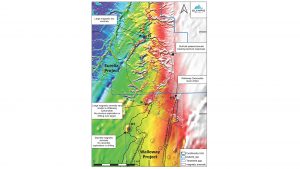
The southern half of the Walloway project is not covered by detailed magnetic data yet contains many discrete anomalies with geological context conducive to carbonatite intrusion. Target W2 is of very high priority and occurs in a similar geological context to Walloway carbonatite, on the edge of the Curdimurka basal breccia. A detailed aeromagnetic survey is planned over the southern portion of the Walloway ELA to help characterise these exciting targets.
Future work
Since acquiring the project in December 2022, Olympio has rapidly identified numerous high-priority carbonatite and kimberlite targets in a province with demonstrated widespread REE/Nb prospectivity. Olympio is committed to an aggressive and well-funded future work programme to unlock REE exploration potential of this previously overlooked carbonatite province.
Please note, this article will also appear in the fourteenth edition of our quarterly publication.

